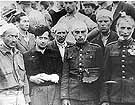
|
|
|

|

|

|

|
|
Click on an image to see a larger, more detailed picture.
|
|
|
|
|
| 1946: The Pursuit of Justice |

|
pg. 647 |

|
|
|
|
| |
 Jewish Holocaust survivors who sought to enter Palestine illegally and who were captured by the British were detained in several DP camps. Thousands of these Jews were sent to Cyprus, seen here, where they were forced to endure poor, limited food; shortages of water; overcrowding; and inadequate sanitation. The bitter irony of the whole situation was not lost on the world's Jews.
Jewish Holocaust survivors who sought to enter Palestine illegally and who were captured by the British were detained in several DP camps. Thousands of these Jews were sent to Cyprus, seen here, where they were forced to endure poor, limited food; shortages of water; overcrowding; and inadequate sanitation. The bitter irony of the whole situation was not lost on the world's Jews.
Photo: Archive Photos: F116MZS
|
 This man was among the survivors of the Kielce pogrom. While recovering in the hospital, he said: "I was in Oswiecim [Auschwitz] for three years. It was awful there; but here in Kielce it was even worse. Everything was breathing hatred. The corpses of murdered people were massacred, trampled upon." The end of the Holocaust, obviously, had not brought an end to antisemitism in Europe.
This man was among the survivors of the Kielce pogrom. While recovering in the hospital, he said: "I was in Oswiecim [Auschwitz] for three years. It was awful there; but here in Kielce it was even worse. Everything was breathing hatred. The corpses of murdered people were massacred, trampled upon." The end of the Holocaust, obviously, had not brought an end to antisemitism in Europe.
Photo: Julia Pirotte
|
 Kielce Pogrom
Kielce Pogrom
Prejudice and hatred toward Jews did not end with the Nazis' defeat. Few Polish Jews survived the Nazis' death camps, and yet even those few who did were often greeted with violent hostility when they returned to their homes. Before the war, the city of Kielce in southeast Poland had included some 15,000 Jews among a population of about 60,000. In 1946 about 200 Jews were living in Kielce, most of them waiting to immigrate to Palestine. For some Poles in the town, any Jewish presence was unwelcome. The embers of hatred burst into flames when a Christian child disappeared. Townspeople accused the Jews of ritual murder, claiming that the Christian child had been abducted so that his blood could be used in a satanic ritual. A wave of deadly antisemitic violence was unleashed before the child (who had been staying with a friend) was found. Forty-two Jews were killed, dozens of others, including those pictured, were injured. The attackers included police and even a Catholic priest. As the story of the killings spread, Jews fled in terror, shocked to have survived the Nazis' death camps only to return to their homes to be murdered by antisemitic Poles.
Photo: Wide World Photo / United States Holocaust Memorial Museum Photo Archive
|
|

|

|

|

|
 May 7, 1946: Dutch Nazi leader and collaborator Anton Mussert is hanged, one year to the day of his arrest, after being convicted of war crimes.
May 7, 1946: Dutch Nazi leader and collaborator Anton Mussert is hanged, one year to the day of his arrest, after being convicted of war crimes.
|
 May 25, 1946: Switzerland signs the Washington Agreement, under which the Swiss government will voluntarily contribute $58.1 million in gold to an Allied commission established to help rebuild Europe. The Allies are aware that this payment will come from Swiss stores of looted gold taken from Jews and other victims of Nazi persecution. Regardless, the Allies agree not to press the Swiss for additional claims. At this time, Switzerland holds between $300 and $400 million in looted gold; See 1951.
May 25, 1946: Switzerland signs the Washington Agreement, under which the Swiss government will voluntarily contribute $58.1 million in gold to an Allied commission established to help rebuild Europe. The Allies are aware that this payment will come from Swiss stores of looted gold taken from Jews and other victims of Nazi persecution. Regardless, the Allies agree not to press the Swiss for additional claims. At this time, Switzerland holds between $300 and $400 million in looted gold; See 1951.
|
 May 29-June 1, 1946: Ten former members of the Natzweiler, Germany, camp are tried at Rastadt, Germany. One is sentenced to death and five to imprisonment; four are acquitted.
May 29-June 1, 1946: Ten former members of the Natzweiler, Germany, camp are tried at Rastadt, Germany. One is sentenced to death and five to imprisonment; four are acquitted.
|
|
|
|
|
| 1946: The Pursuit of Justice |

|
pg. 647 |

|
|
The Holocaust Chronicle
© 2009 Publications International, Ltd.
|
|
